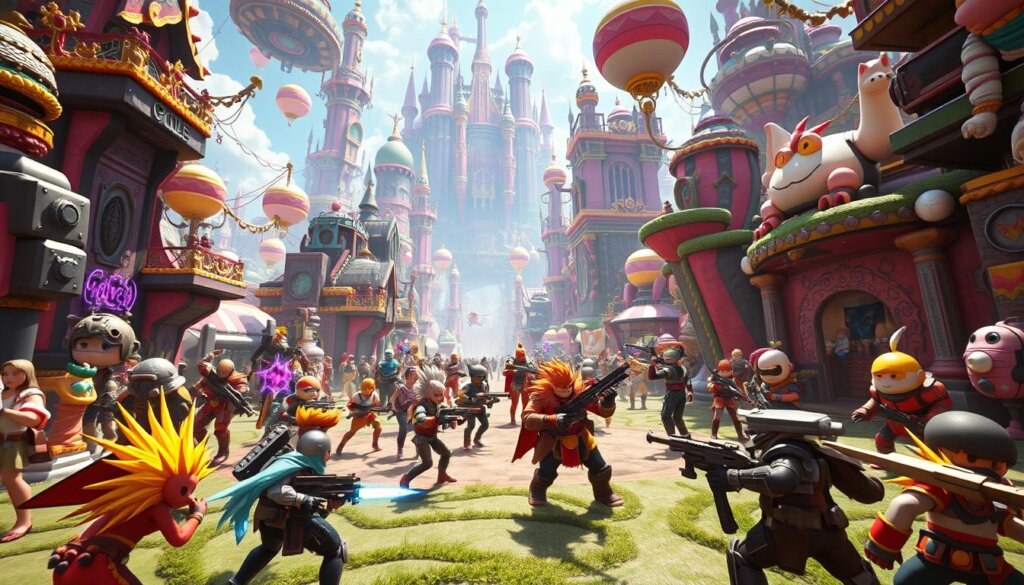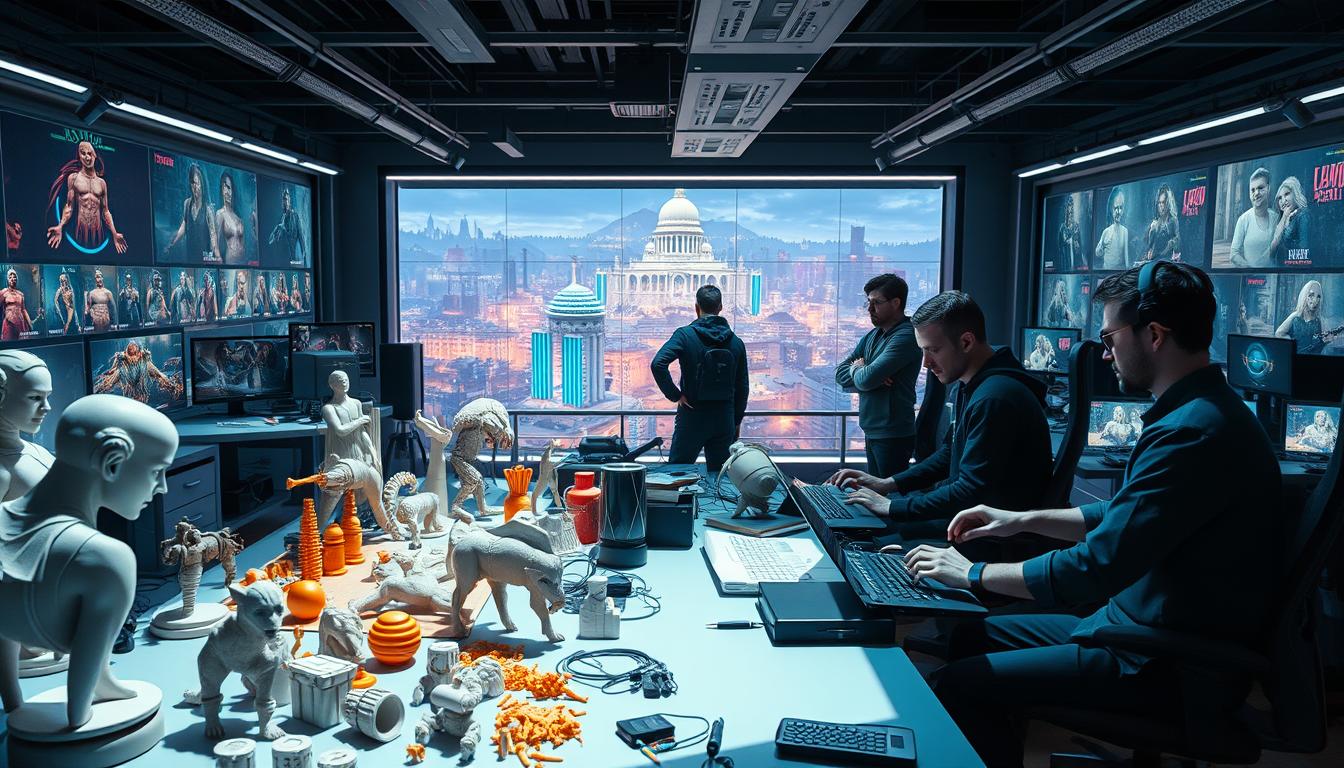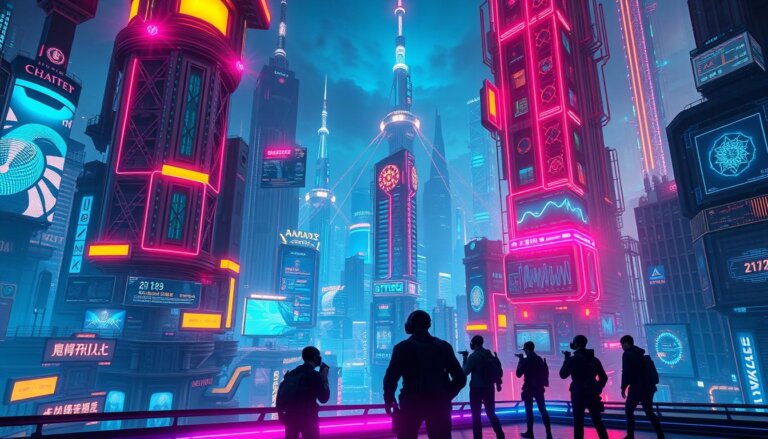Your Guide to Understanding How UGC is Reshaping Game Development
Are you ready to discover the future of gaming? The rise of user-generated content is changing the industry in big ways. With ugc platforms growing, the old ways of making games are being challenged.
This change isn’t just about how games are made. It’s also about how we play and make money from them. As a player or developer, you might wonder what this means for you and the whole industry. In this guide, we’ll look at how user-generated content is affecting traditional ways and the new chances it brings.
The Rise of User-Generated Content in Gaming
User-generated content in gaming has changed the game. Now, you’re not just playing; you’re creating. You add to the game’s world.

Defining UGC in the Gaming Context
User-generated content (UGC) means anything made by players, not developers. This includes custom levels, characters, and game modes. It’s making games more fun and replayable.
Types of User-Generated Content in Games
UGC includes many things, like:
- Custom levels and maps
- User-designed characters and skins
- New game modes and challenges
The Value Proposition of Player-Created Assets
Player-created assets make games last longer and keep players engaged. They offer unique experiences. This helps both players and developers by building a community.
Historical Evolution of Player Contributions
UGC has grown a lot over time. It started with modding communities and now includes big UGC platforms. Player contributions are key to game development.
From Modding Communities to Mainstream UGC
The shift to mainstream UGC is big. Games like Minecraft and Roblox have made UGC central to their appeal.
Key Milestones in UGC Adoption
Important moments include the start of level editors and community content platforms. Also, UGC being added to big games. These steps led to today’s UGC-focused gaming world.
How UGC is Eating Traditional Game Development
The gaming world is changing fast with User-Generated Content (UGC). Players are now making and sharing game content. This is shaking up how games are made and played.
The Shift from Developer-Centric to Player-Centric Models
The focus is moving from developers to players. This change is altering how games are made and enjoyed.
Changing Development Priorities and Resource Allocation
Now, making game creation tools and platforms for players is key. Resources are being used to support content made by the community.
Player Expectations in the UGC Era
Players want games that are more interactive and customizable. They want to make and share their own content. This has led to more player-made worlds that are rich and varied.
Economic Impact on Traditional Studios
UGC is having a big impact on traditional studios. The move to player-centric models is changing how they make money.
Revenue Model Disruption
Old ways of making money are being challenged. Players are spending more on content made by others. Studios must find new ways to make money.
Adaptation Strategies for Survival
To stay afloat, traditional studios are embracing UGC. They’re working on platforms that support content from the community.
| Aspect | Traditional Game Development | UGC-Driven Game Development |
|---|---|---|
| Content Creation | Developer-created content | Player-generated content |
| Revenue Model | Game sales and DLC | In-game purchases and community-driven sales |
| Player Engagement | Limited to pre-defined content | Dynamic and constantly evolving |
The Business Case for UGC-Focused Games
UGC-focused games are becoming more appealing as the gaming world changes. They offer a new way to make games, shifting from the old ways.
Cost Efficiency and Resource Allocation
One big plus of UGC games is how they save money. They use content made by players, cutting down on the cost of making lots of game content.
Development Cost Comparison: Traditional vs. UGC
Old-school game making costs a lot upfront for content. But UGC spreads this cost out among players, easing the financial load on developers.
Scaling Content Without Scaling Teams
UGC lets developers grow their game without needing more people. This means better use of resources and possibly more profit.
Community Engagement and Player Retention
UGC games also boost community involvement and keep players coming back. By letting players add to the game, developers build a more dedicated and lively community.
Metrics That Matter in UGC Ecosystems
Important metrics for UGC games include how engaged players are, how much content they make, and how the community grows. These show how well the game is doing.
Long-Tail Revenue Generation
UGC games can keep making money over time. They keep players interested and add new content, making a steady flow of income.
Leading UGC Platforms Transforming the Industry
Several UGC platforms are changing the gaming world. They let players create, share, and interact with content. This is changing how games are made and played.
Roblox: The UGC Pioneer
Roblox is a leading UGC platform. It lets users make and sell their own games. Its success shows UGC’s big impact on gaming.
Platform Architecture and Creator Tools
Roblox has a strong platform and tools for developers. It’s easy to use and has lots of resources. This makes it a top choice for creators.
Success Stories from the Roblox Ecosystem
The Roblox ecosystem has many success stories. Top developers make a lot of money from their games. These stories motivate new creators.
Minecraft: Building Worlds Together
Minecraft is a big UGC platform. It lets players build and share their creations. Its block-based world is a canvas for creativity.
From Blocks to Businesses
Minecraft’s UGC model has led to businesses. These include merchandise, tutorials, and community servers. It has grown the game’s ecosystem.
Educational Applications and Beyond
Minecraft is also used in education. It promotes STEM learning and creativity. Its world makes complex ideas easier to understand.
Dreams: PlayStation’s Creative Powerhouse
Dreams is a UGC platform by PlayStation. It offers creative tools for game development. It’s a place for artistic expression in the PlayStation community.
Accessibility and Artistic Expression
Dreams focuses on making it easy for creators. It has an intuitive interface. This has built a community of artists and developers.
Community Highlights and Achievements
The Dreams community shows off its best creations. Some are even featured on PlayStation’s official channels. This recognition inspires creators to be more innovative.
Tools and Technologies Empowering Player Creativity
New game development tools are changing the game. They make it easier for players to create their own content. This is thanks to new technologies that make game making more accessible than ever.
Accessible Game Creation Systems
Today’s game creation systems are easy to use. They let players turn their ideas into games without needing to know how to code. This is changing how games are made.
Visual Scripting and No-Code Solutions
Visual scripting and no-code solutions are leading the way. They let creators make complex games with simple interfaces, not code. This makes it easier for new creators to start.
Asset Libraries and Sharing Ecosystems
Asset libraries and sharing ecosystems help players work together. They offer a wide range of assets, letting creators focus on their unique ideas. This builds a community around shared creativity.
AI-Assisted Content Generation
AI is helping players create more content. It makes high-quality content faster and easier.
Procedural Generation Tools
Procedural generation tools create content like terrain and levels on the fly. They add endless variety to games, keeping players interested.
Machine Learning in Creative Workflows
Machine learning is being used in game making. It helps with tasks like texture generation and animation. This lets creators focus on the fun parts of making games.
| Technology | Description | Impact on Game Development |
|---|---|---|
| Visual Scripting | Intuitive interfaces for creating game mechanics without coding. | Lowers barrier to entry for new creators. |
| Procedural Generation | Algorithms for generating content on the fly. | Enables endless variety in game content. |
| Machine Learning | Assists with tasks like texture generation and animation. | Streamlines creative workflows. |
The Creator Economy Within Gaming Ecosystems
The rise of user-generated content (UGC) has created a booming creator economy in gaming. Gamers are now content creators, adding to the richness of gaming. This change has opened doors for creators to make money and grow their personal brands.
Monetization Opportunities for UGC Creators
UGC creators can explore different ways to make money in the gaming world. Two main methods have become popular:
Revenue Sharing Models
Many gaming platforms now share revenue with creators. They can earn up to 50% of the revenue from their content. This gives creators a big incentive to create high-quality content.
Subscription and Premium Content Strategies
Platforms also offer subscription models and premium content. This lets creators earn more by offering exclusive content. By doing so, they can attract more subscribers and boost their income.
From Hobbyist to Professional Game Designer
The creator economy is opening up new career paths for game design enthusiasts. Now, creators can turn their hobby into a professional career. They can use their skills and creativity to build successful careers.
Career Pathways in UGC Development
UGC development offers many career paths. You can work in content creation, community management, game design, or development. Creators can choose areas that fit their skills and interests, with chances for growth and advancement.
Building Your Portfolio and Brand
To thrive in the creator economy, building a strong portfolio and brand is key. Showcasing your work and engaging with the community helps establish your reputation. This can lead to more opportunities.
| Monetization Strategy | Description | Benefits |
|---|---|---|
| Revenue Sharing Models | Platforms distribute a percentage of revenue to creators | Direct earnings based on content performance |
| Subscription and Premium Content | Creators offer exclusive content or benefits for a fee | Recurring revenue, increased creator control |
Getting Started with Creating Your Own Game Content
Creating game content is now easier than ever thanks to UGC platforms. The first step is to pick the right platform for your skills. You also need to know the key skills for UGC creators.
Choosing the Right Platform for Your Skills
It’s important to choose a UGC platform that fits your abilities. Each platform is designed for different skill levels and interests.
Beginner-Friendly UGC Environments
Platforms like Roblox and Minecraft are great for beginners. They have easy-to-use tools that help you get started.
Matching Your Ideas to Platform Capabilities
Think about what kind of content you want to make. Pick a platform that can support your ideas. For example, Minecraft is perfect for creating detailed worlds.
Essential Skills for Aspiring UGC Creators
While some platforms are easy to use, having certain skills can boost your creativity. These skills can make your work better and faster.
Technical vs. Creative Requirements
The skills you need vary by platform. You might need to know basic scripting or advanced programming. It’s important to balance your technical skills with your creative ideas.
Learning Resources and Communities
Look for online forums and tutorials to learn from others. The communities around UGC platforms offer support and inspiration.
| Platform | Beginner-Friendly | Technical Requirements |
|---|---|---|
| Roblox | Yes | Basic scripting |
| Minecraft | Yes | Minimal coding |
| Dreams | Yes | Creative skills |
Challenges and Limitations of UGC Models
UGC models bring many benefits but also face challenges for growth. As gaming welcomes more user-generated content, it’s key to know these hurdles. This is important for both developers and players.
Quality Control and Curation Issues
Keeping quality high is a big challenge for UGC models. With so much content, it’s hard to ensure it meets standards.
Discoverability in Crowded Marketplaces
Finding good content in a crowded space is tough. Players often get lost in the sea of user-generated games and assets.
Maintaining Standards at Scale
As more UGC is created, keeping standards up is harder. Platforms need good moderation tools to follow community rules.
Intellectual Property Concerns
Intellectual property issues are a big problem in UGC models. The shared nature of these platforms can lead to copyright problems.
Copyright Challenges in Collaborative Environments
It’s hard to figure out who owns what in shared spaces. This can cause disputes and legal issues.
Platform Policies and Creator Rights
Platform rules are key to protecting creators. Having clear guidelines and strong IP protection is vital for a safe and creative community.
The Social Impact of Community-Driven Game Development
Community-driven game development is changing the game world. It’s making games in new ways and affecting society deeply.
Democratization of Game Creation
This approach is making game making open to all. It’s changing how games are made.
Lowering Barriers to Entry
Now, anyone can make games thanks to easy tools. This chance is open to those who couldn’t before.
Diverse Voices and Perspectives
More people are joining the game world. This brings in different ideas and styles, making games more interesting.
Building Communities Around Shared Creativity
Game development is creating new communities. These groups work together and share ideas online.
Collaborative Development Models
Creators are teaming up on games. They share their skills, making games more complex and fun.
Social Networks Within Creation Platforms
Online spaces let creators meet and share. This builds a community and boosts creativity.
| Aspect | Traditional Game Development | Community-Driven Game Development |
|---|---|---|
| Creator Base | Limited to professional developers | Open to all, including hobbyists and enthusiasts |
| Development Tools | Specialized, often expensive software | User-friendly, accessible tools |
| Community Engagement | Limited community involvement | High level of community engagement and participation |
Future Trends: Where UGC and Game Development Are Heading
The rise of UGC is changing game development. It’s opening new doors for creators and players. Several trends are emerging that will shape the industry.
Metaverse Integration and Cross-Platform Creation
The metaverse is blurring lines between gaming platforms. This change makes cross-platform creation easier. Developers can now create content for various platforms.
Interoperable Assets and Experiences
Metaverse integration allows for interoperable assets and experiences. Players can use their in-game items across different platforms. This enhances the gaming experience.
Virtual Economies and Digital Ownership
Virtual worlds are making digital ownership popular. Players want to own their in-game assets. Blockchain technology is being explored to make this possible.
Emerging Technologies Shaping UGC
Other technologies are also shaping UGC. These technologies improve the creative process and open new ways to make money.
Blockchain Applications in Creator Economies
Blockchain is creating decentralized creator economies. It lets creators monetize their content in new ways, like with NFTs.
AI Co-Creation and Assisted Design
AI is enhancing the creative process. AI tools help create new content, like 3D models and game levels, more efficiently.
These trends will deeply impact the gaming industry. The future of game development will be more collaborative, dynamic, and focused on the player.
| Trend | Description | Impact |
|---|---|---|
| Metaverse Integration | Seamless cross-platform creation and interoperability | Enhanced gaming experience |
| Blockchain Technology | Decentralized creator economies and digital ownership | New monetization opportunities |
| AI-Assisted Design | Enhanced creative process and efficiency | Increased productivity for creators |
Conclusion: Navigating the New Landscape of Game Creation
You are now part of a rapidly evolving gaming industry. User-generated content is changing how games are made, played, and sold. With game creation tools, players are becoming creators, leading to a more collaborative model.
The move towards UGC-focused games is more than a trend. It’s a big change in how the industry works. By using user-generated content, developers can make more varied and fun games. Players can show their creativity and share their work, changing the gaming world.
To succeed in this new world, you need to know the trends and tech shaping it. Platforms like Roblox and Minecraft are leading the way. By embracing these changes, you can find new chances for creating games and engaging with communities.
FAQ
What is User-Generated Content (UGC) in gaming?
User-Generated Content means players create their own game content. This includes custom levels, characters, and game modes. It makes games last longer and keeps players interested.
How is UGC changing traditional game development models?
UGC is moving the focus from developers to players. This change affects how games are made and sold. Studios must adjust to stay competitive.
What are the benefits of UGC-focused games for developers?
UGC games save money and keep players engaged. They also let developers add more content without growing their team. This makes UGC games a smart choice for developers.
What are some leading UGC platforms in the gaming industry?
Top UGC platforms are Roblox, Minecraft, and Dreams. They give players tools to make and share their own games. This has changed how games are made and played.
What tools and technologies are empowering player creativity in UGC?
Tools like accessible game creation systems and visual scripting help players be creative. No-code solutions, asset libraries, and AI also play a big role in empowering player creativity.
How can UGC creators monetize their content?
UGC creators can make money through revenue sharing and subscription services. They can also sell premium content. This opens up new ways for creators to earn.
What are some challenges and limitations of UGC models?
UGC models face issues like quality control and finding good content. There’s also the challenge of standing out in a crowded market. Intellectual property concerns need to be handled too.
How is UGC impacting the social aspect of gaming communities?
UGC makes game creation open to everyone. It brings different voices and perspectives to games. This builds communities around shared creativity, offering new ways to connect and interact.
What are some future trends shaping the UGC and game development landscape?
Trends include the metaverse, cross-platform creation, and virtual economies. Blockchain and AI are also changing the industry. These changes will keep transforming gaming.







